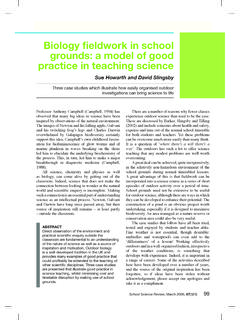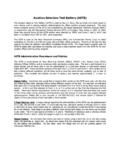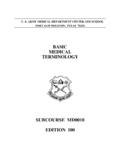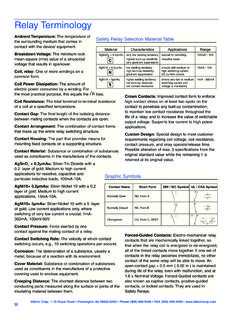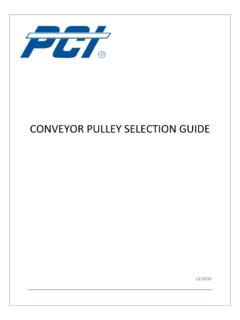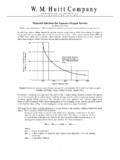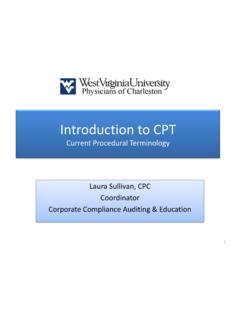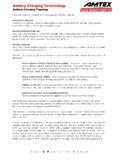Transcription of THE LANGUAGE OF MEASUREMENT - Getting Practical
1 1 Published by ASE Publications on behalf of ASE-NuffieldTHE LANGUAGE OFMEASUREMENTTe r m i n o l o g y u s e d i n s c h o o lscience investigations5 IntroductionStructure of the bookletThe booklet contains a glossary of key terms, plus a selection of investigationsillustrating the terms (shown in bold text and with a cross reference back to theglossary) being used in context. The examples, drawn from school level biology,chemistry and physics, are written in an idealised pupil voice , which shows possibleend points for an able pupil. A commentary is offered below each section of pupilmaterial in the example investigations and is distinguished by italic text. Thecommentary explains the terms being used and how these are appropriate. Someexamples indicate ways that the investigation, or the terminology used, might bemodified for use with younger and/or older pupils.
2 It is useful to have the glossary tohand when you read the illustrative glossaryThe glossary is presented in three Parts, each of which contains a group of conceptsassociated with one aspect of experimenting and 1: MeasurementsPart 2: Measuring instruments and measuring systemsPart 3: Designing and evaluating school science investigationsWithin each part, the concepts are listed in order of meaning, rather thanalphabetically. More basic terms are introduced first; later terms build from the given to every term in the glossary have been carefully considered. (See The process leading to this publication below.) Wherever possible, we simplify thelanguage used by metrologists, yet avoid any oversimplification that could lead toconfusion and misinterpretation.
3 The booklet is aimed at adult readers with a goodscientific understanding. It is not intended for a pupil investigationsThe purpose of the example investigations is to illustrate terms being used in thecontext of school level experiments. They are not intended as examples of teachingactivities to be undertaken by pupil voice used in the illustrative investigations indicates ideas and termsthat can be discussed with pupils. It does not suggest what pupils should be achieving,The aim of this booklet is to enable teachers, publishers, awarding bodies and othersto achieve a common understanding of important terms that arise from practicalwork in secondary science, consistent with the terminology used by professionalscientists. This vocabulary underpins all empirical science and so is applicable notonly to school science experiments but also to evaluating aspects of scientific claimsmade in the public booklet does not cover a complete range of how science works skills.
4 Forexample, little of the terminology used when evaluating science-related media claimsis included, for a Gateway Science in the News task or a Case Study in TwentyFirst Century Science. Note also that presentation of data in this publication, intables and graphs, is incidental and not of primary it should not be used as a guide for assessing pupil understanding of theprinciples of MEASUREMENT and experimental design. Science teachers must judge forthemselves what terms to introduce to their pupils and how to achieve progressionthrough the secondary school years. Pupil voice is shown as full column width, in normal text; the Commentary isindented slightly and shown as italic and backgroundThe scientific community has developed over time a specialised vocabulary for talkingabout Practical exploration and investigation.
5 Terms such as valid, accurate, precise,error, uncertainty and many more are frequently used in discussing the design andoutcomes of Practical enquiry. Like other examples of specialist terminology , itspurpose is to enable people to communicate clearly and effectively with each otherabout their work and its scienceIn school science, pupils are introduced to some of this vocabulary and the ideas it isdesigned to encapsulate and express. The booklet came to be written because therewere problems with how this was done. There was no general agreement within thescience education community on the terms that were used or their meaning. So wecould find the same word being used to express different ideas, or two (or more)different words being used to express the same idea.
6 It could also be unclear if a wordlike reliability or accuracy was being used as an everyday term, or as a technicalterm with a precise and specific became a more serious issue when pupils were being assessed on theirunderstanding of these words, or their ability to use them correctly and appropriatelyin reports of their own Practical work. Assessment of Practical work, in some form,has long been a part of school science. Since the mid-1980s, this has involvedassessing pupils ability to plan and carry out Practical investigations. The way this hasbeen implemented has increased the prominence of a particular vocabulary for talkingabout aspects of investigation design, and the collection, analysis and interpretation ofdata. More recently, the emphasis on how science works heightened the demand onpupils (and teachers) to be able to talk about these matters in a clear and aspect of the situation that we faced in 2009 was the differences betweenawarding bodies in the terminology used to talk about investigative work.
7 SomeGCSE specifications included a glossary of terms associated with investigative work inscience, but there were differences in the terms included and in how these weredefined. And there were differences in whether (and how) pupils use of these termswas examined in written papers or through coursework. With many specification-related publications there were corresponding differences in teaching materials fromdifferent result was confusion among teachers and pupils about how the specialterminology associated with Practical investigation was to be learned, when it shouldbe used, what specific terms mean, and how they appear in coursework markingcriteria. This was a particular concern for ASE and Nuffield, which publisheducational materials that are intended to be useful for all teachers, whatever sciencecourse or specification they may be word reliability has posed particular difficulties because it has an everydayusage and had been used in school science to describe raw data, data patterns andconclusions, as well as information sources.
8 On the strong advice of the UK metrologyinstitutes, we avoid using the everyday word reliability , because of its ambiguity. Fordata, the terms repeatable and reproducible are clear and therefore better. Forconclusions from an experiment, evaluative statements can mention confidence inthe quality of the enquiryThe core aim of science is to develop explanations for natural phenomena and eventsthat can be seen to be grounded in empirical evidence. Hence scientific enquiry has acentral concern about the quality of evidence and of explanations that are based uponit. This publication focuses on ideas about scientific enquiry that pupils shouldconsider in their own Practical work: Can I rely on the data when drawing aconclusion? Are uncertainties in the measurements small enough?
9 Does the differencebetween one MEASUREMENT and another reflect a real change in the thing beingmeasured?Error and uncertainty approaches to measurementHistorically, the objective of MEASUREMENT was to determine an estimate of the truevalue of some quantity that was as close as possible to that single true value. TheError Approach to MEASUREMENT , as it is called, is still commonly used in schools andcolleges. Unfortunately, school pupils too often think error implies a mistake theyhave made, rather than inherent variations which affect measurements. In recent years, metrology institutes internationally have come to prefer theUncertainty Approach. Here the objective is not to determine a true value as closely aspossible. Rather it assumes that the information from a MEASUREMENT only permits astatement of the dispersion (interval) of reasonable values of the quantity beingmeasured, together with a statement of the confidence that the (true) value lies withinthe stated approaches assume that no mistakes have been made in performing themeasurement.
10 In both approaches, analysis of variation in data enables a responsivescientist (or pupil) to improve the design of the experiment and thus improve thequality of measurements or any result calculated from process leading to this publicationThe issues outlined above came increasingly to the attention of the ASE 11 19 Committee and were discussed by them in autumn 2008. ASE contacted Nuffield inJanuary 2009 to discuss the situation further. It was agreed to invite representatives ofawarding bodies, QCA, Ofqual and the National Strategy, and the UK metrologyinstitutes (as custodians of scientific best practice ) to a meeting in April 2009. As astrategy for improving the situation, it was agreed that work should start frominternationally agreed terminology and adapt it ( simplify it, without deviation ifpossible) to school science needs.


